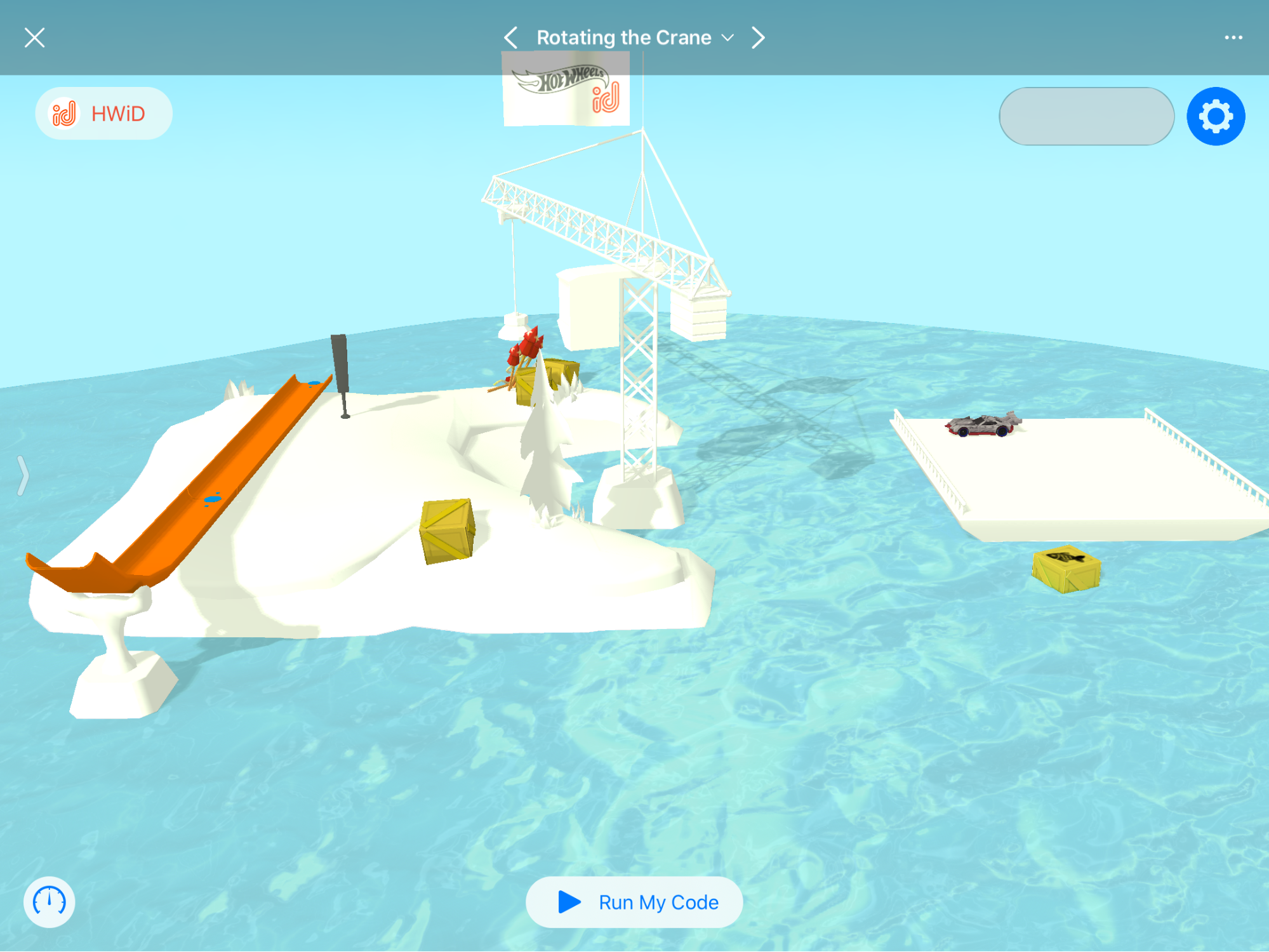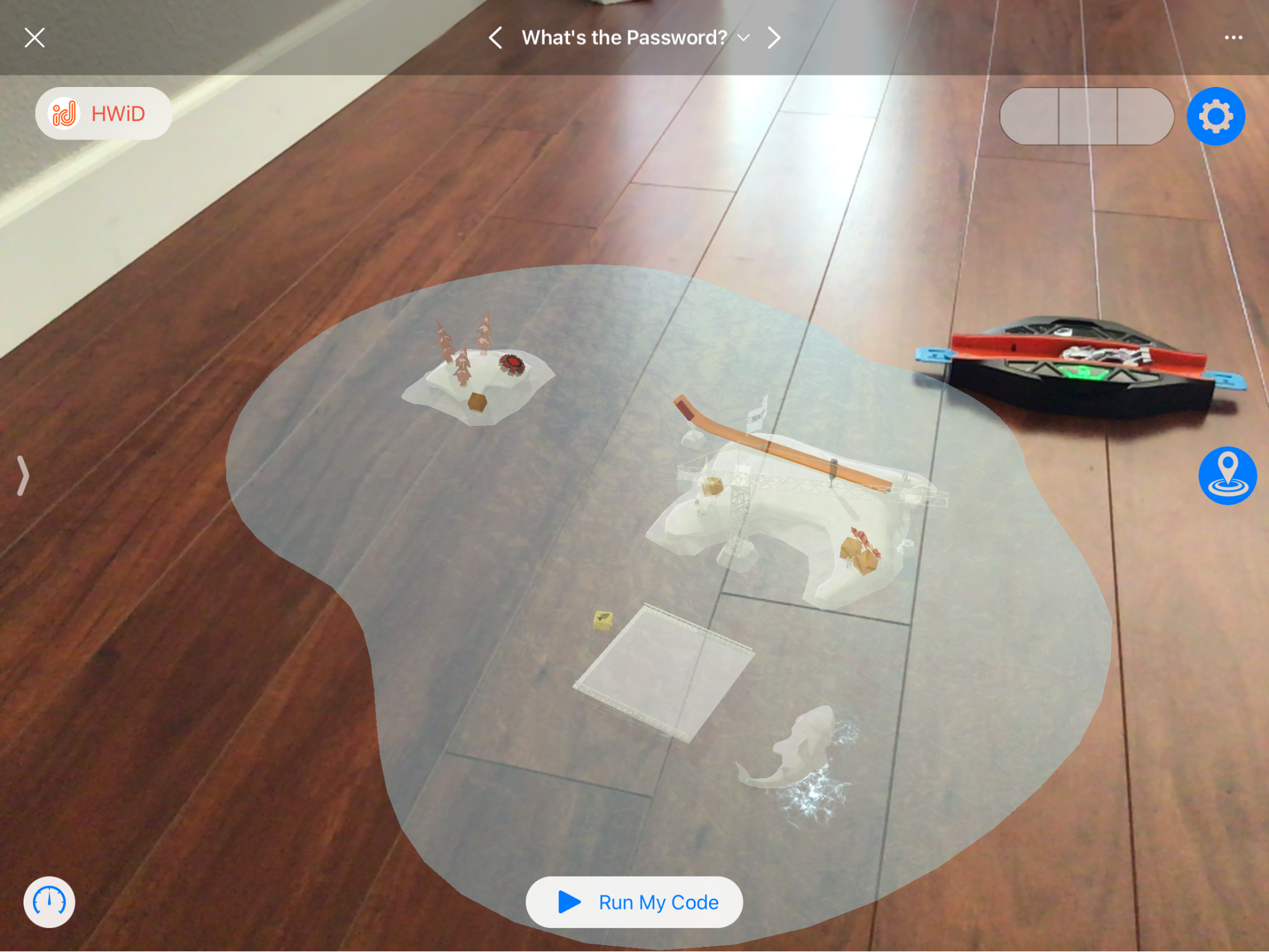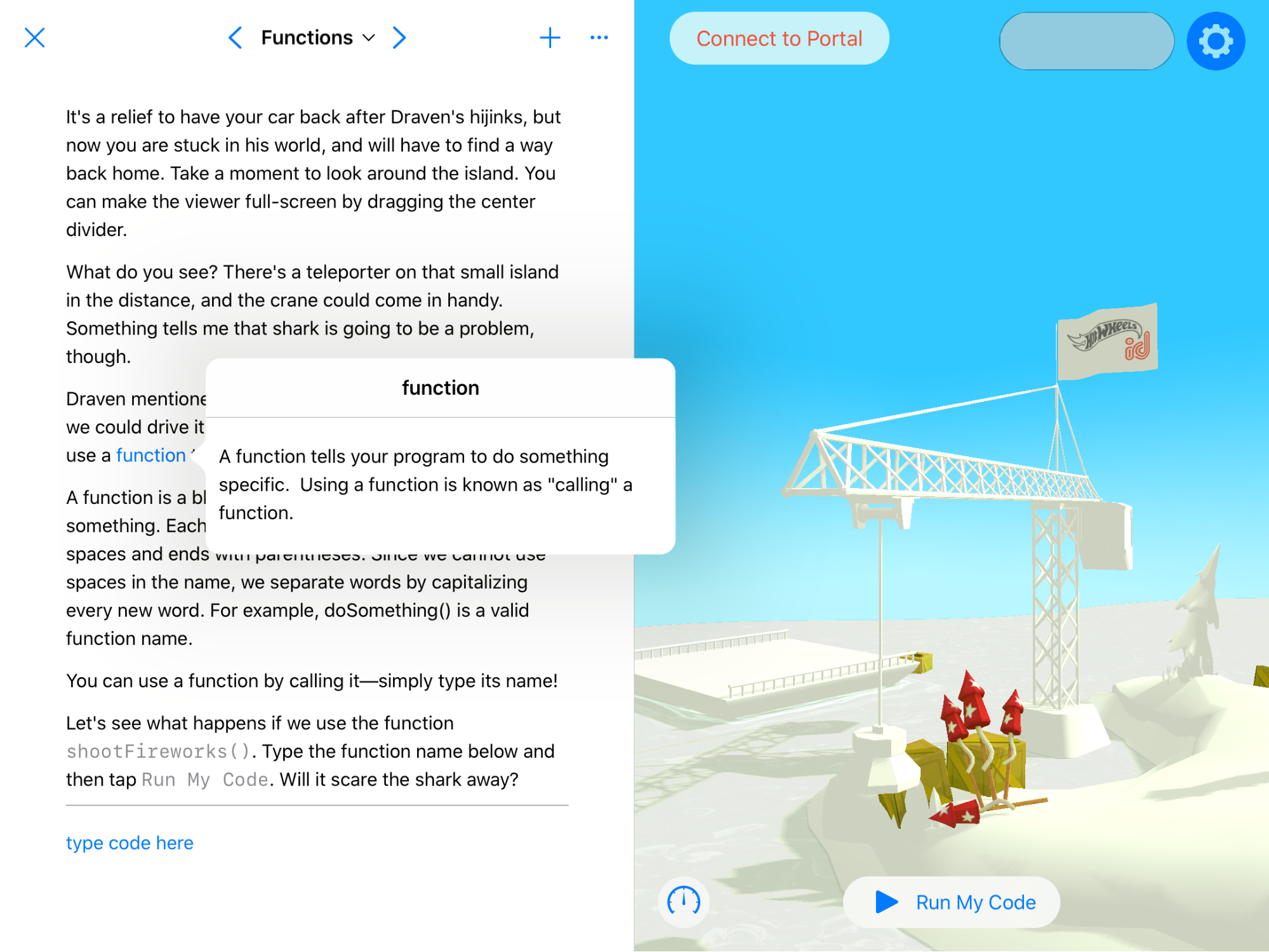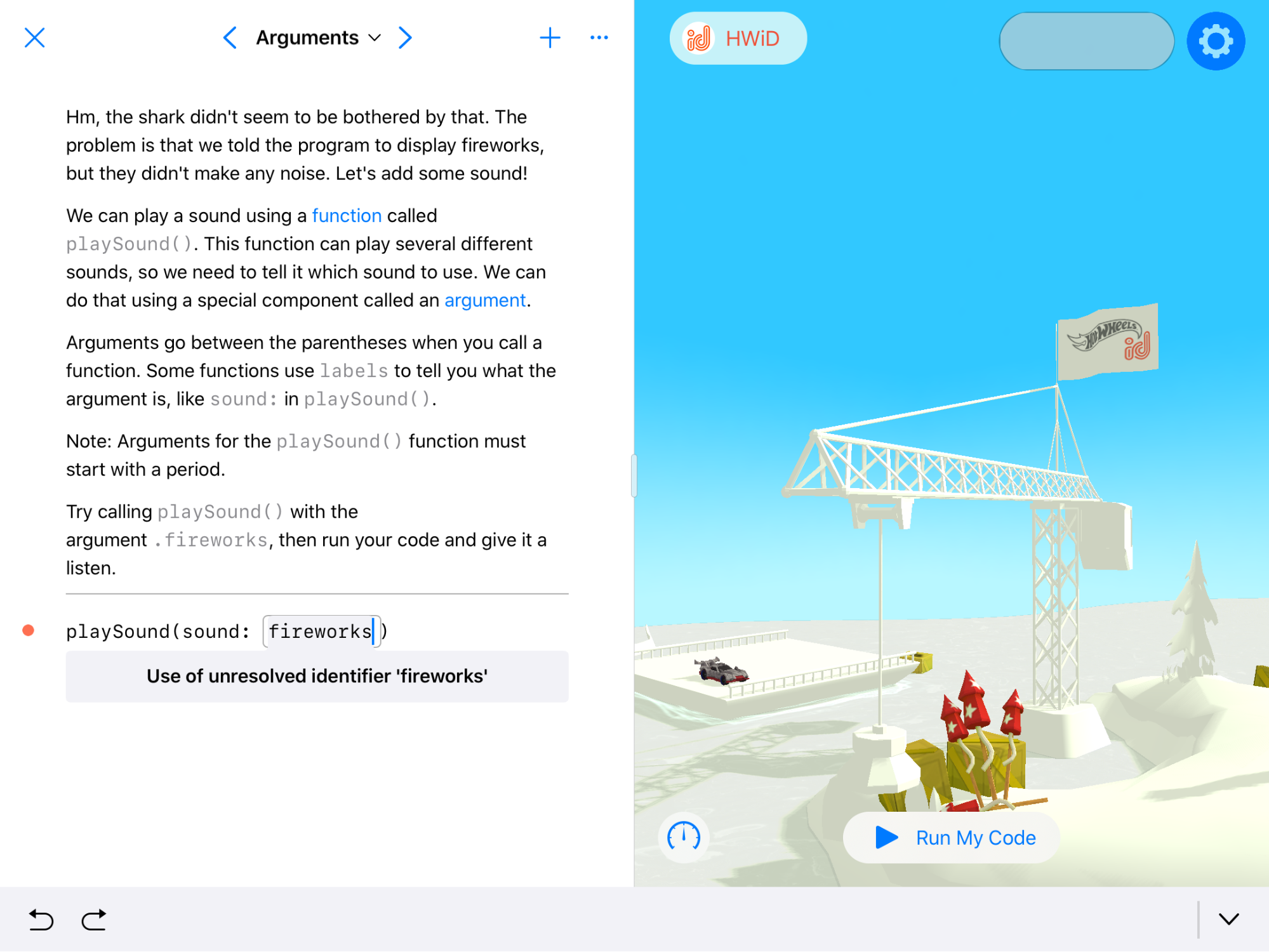Tom's Hardware Verdict
Easy-to-understand lessons with increasing difficulty and fun animations with augmented reality will keep children entertained. But without real-world coding or the ability to write code freely, there will still be more to learn.
Pros
- +
Teaches fundamentals of basic coding and AR well
- +
Fun, captivating lessons with a storyline and increasing difficulty
- +
Groovy tunes
Cons
- -
Codes aren’t applicable in the real world
- -
No free coding
Why you can trust Tom's Hardware
These ain’t your daddy’s Hot Wheels. Mattel is embracing into the age of technology -- and kids’ fascination with it -- with its line of Hot Wheels id cars. Each has an NFC (near field communication) tag that sends data to a mobile device so kids can track their cars and their usage and play games in the companion (iOS / Android) app. Like the best STEM toys, these tech-infused toy cars are getting a coding spin with coinciding chapters in Apple’s Swift Playgrounds iPad app that are meant to teach kids about coding while incorporating a splash of augmented reality (AR).
For kids 8 and up, the Hot Wheels id cars combined with the Hot Wheels id Race Portal ($39.95, includes two Hot Wheels id cars), the toy will stimulate kids’ minds much more than if they were just flinging them across the living room. Now they can actually get your kids excited about coding concepts and AR.
Hot Wheels id Cars
Hot Wheels id cars are different from regular Hot Wheels because each has an NFC tag from NXP, which invented the technology, on its underside. The tag has a microchip and uses wireless radio communications to transfer data to a supporting mobile device within a few inches. After downloading the free Hot Wheels id app, children can tap the car to a smartphone with NFC capabilities. The car’s info is then downloaded from the car to the phone via the same tech leveraged with Apple or Google Pay. The NFC tag provides each Hot Wheel id car with a unique ID, allowing users to track stats in the app, like the fastest speed traveled, number of laps and miles driven and how many races and games in the app it’s won.
Hot Wheels id cars start at around $6.95. To connect it to the app, you’ll need either a device that supports NFC (just tap the car to the device) or a Hot Wheels id Race Portal ($39.95), which has a scanner and can attach to other tracks. For more, see our first hands-on with Hot Wheels id cars. There’s also a Smart Track Kit ($180) for building a wild track and also includes a reader.
Hot Wheels id Specs
| Hot Wheels id Car ($6.99) | NFC tag: NXP NTAG | Row 0 - Cell 2 |
| Hot Wheels Race Portal ($39.99) | NFC reader; Bluetooth Low Energy; 2x infrared sensors; 4MB on-board memory; Rechargeable 500 mA lithium polymer battery with NXP Power Management; Includes: 2x exclusive Hot Wheels id cars | Row 1 - Cell 2 |
| Hot Wheels id Swift Playgrounds Playbook | Supported by iPads with iOS 11 and an A9 CPU or later: iPad Pro (all models); iPad Air (3rd generation); iPad Mini (5th generation) iPad (5th generation or later) | Row 2 - Cell 2 |
| Smart Track Kit ($179.99) | 16x track pieces with microcontroller; 1x Booster microcontroller; 1x LED light; 2x infrared sensors; Includes: 2x exclusive Hot Wheels id cars, 1x Hot Wheels Race Portal | Row 3 - Cell 2 |
Coding With Swift Playgrounds
To enjoy the Hot Wheels id chapters available in Swift Playgrounds, an iPad-only app for teaching kids code, you’ll need an iPad that supports AR. That’s any iPad with an A9 or later CPU (any iPad Pro, the 2019 iPad Air, the 2019 iPad Mini or an iPad from 2017 or later) running iOS 11. You’ll also need the Hot Wheels Race Portal for scanning the cars, which the Playgrounds app will prompt kids to do while coding.
In the Hot Wheel id chapters, one of your Hot Wheels is stolen by Draven, a deranged toy-looking scientist. Kids are tasked through a series of adventures where they need to code their way out of trouble and get their car back.
Like with many STEM toys today, the coding kids do here is only applicable to this toy, not in the real world. That means no one’s walking away a coding master after completing all the chapters. But kids will have the groundworks for understanding how real-life coding works.
Get Tom's Hardware's best news and in-depth reviews, straight to your inbox.


From the jump, the coding app will grab kids’ attention with its thorough yet simple explanations. The colorful animations are also fantastically detailed, allowing kids to zoom in and out, spin around or have fill up the entire screen of the iPad. In one lesson where you’re tasked to crane lift your car from one island to another, dropping it in the water results in a realistic splash.
A progress bar up top keeps kids on track, and they can click on it to be reminded of objectives required before moving to the next lesson. It’ll also prompt you if you’ve written code that won’t work, although it could be more obvious with more kid-friendly text.
Mindful touches like this help ensure kids don’t exit the app out of frustration forever. Bonus points for the app’s delightful soundtrack, which had me grooving but kids can toggle off if they need to focus.
Many STEM apps opt for the simplicity and appeal of block coding. But here you’re using JavaScript-like coding. The app’s instructions will teach kids how to format it, and predictive text that pops up along the bottom of the app also makes it easy enough for kids 8 and older. This also comes in handy for kids with little patience or who don’t like typing on iPads.
The chapters do a great job of teaching kids coding terms. For example, the intro chapter has a paragraph explaining what functions are. That and other key terms are then written in blue throughout the lessons, and kids can click on it for a pop-up definition.
Again, keeping kids engaged is key with any toy, especially a STEM one when you’re trying to sneak in what’s basically a four-letter word to most kids-- educational. Thankfully, these coding chapters encourages kids to keep playing by having a continuous storyline and making each lesson progressively challenging.
In addition, some STEM toys rely too heavily on the app with the hardware being a secondary component, such as the Kano: Star Wars The Force Coding Kit, which has a motion sensor controller but most of the coding is related to an animation viewed on a PC or tablet. The Hot Wheels Playgrounds chapters app do a good job of incorporating the hardware, in this case a Hot Wheels id car and the scanner. The physical car you scan is what appears on the app. And to escape the island in the first chapter, for instance, the animated car has to jump a ramp, so kids have to rev their car in real life. Another lesson has kids rev the car to a target speed.
Some of the lessons incorporate AR. And, of course, AR is one of the technical terms that Mattel app does a great job explaining to children. The app was very responsive and allowed me to work the AR without frustration. Using it calls for a flat surface so you can scan the Race Portal with the iPad’s camera. I didn’t have trouble getting this to work and didn’t have to tweak any lighting, including on a multi-colored kitchen countertop or wooden floor.
Currently, there are three chapters available with numerous lessons each, targeting coding fundamentals, variables and if/less logic and custom functions and loops. Mattel told me that there will be more updates in 2019, but wouldn’t get into specifics. However, these three chapters are enough to keep kids entertained for hours.
Bottom Line
Who would’ve thought Hot Wheels would ever put technology in the driver’s seat? With an NFC tag for tracking data via the mobile app and now the ability to incorporate coding and AR, Hot Wheels is sticking to its roots while staying relevant in a market increasingly dominated by tech.
But the coding skills here aren’t applicable in the real world. Additionally, there’s no section for free coding like with other STEM toys, like the Sphero Bolt. So once your child finishes the three chapters, it’ll be over (until Mattel adds updates in January or new chapters). However, kids will enjoy the captivating animations while getting comprehensive lessons on coding concepts like functions and variables.
With a free app, Hot Wheels evolves into a way to teach kids the fundamentals of coding and experience AR, perhaps for the first time. This is an easy way to make playing with toys an educational experience and worth taking for a spin.

Scharon Harding has over a decade of experience reporting on technology with a special affinity for gaming peripherals (especially monitors), laptops, and virtual reality. Previously, she covered business technology, including hardware, software, cyber security, cloud, and other IT happenings, at Channelnomics, with bylines at CRN UK.



